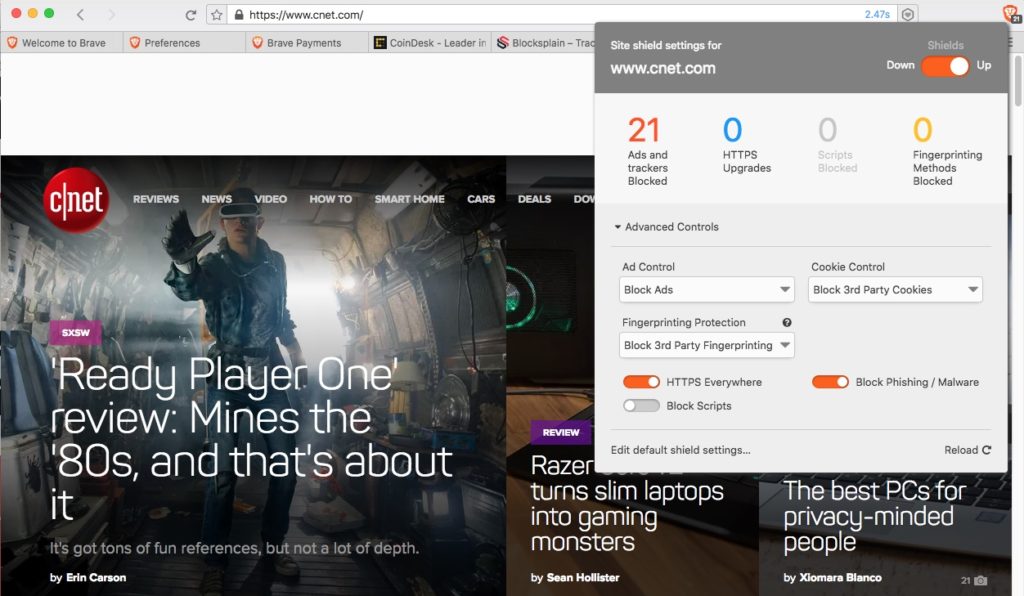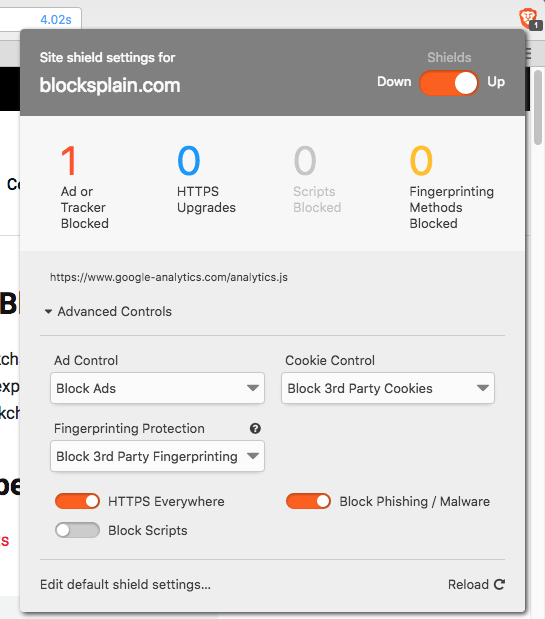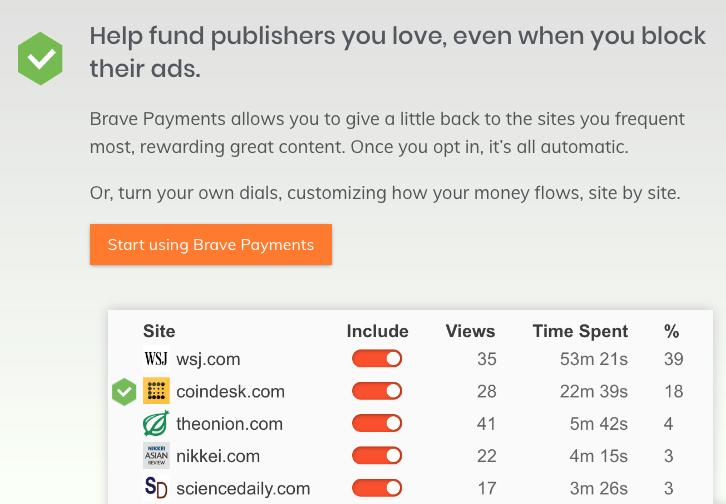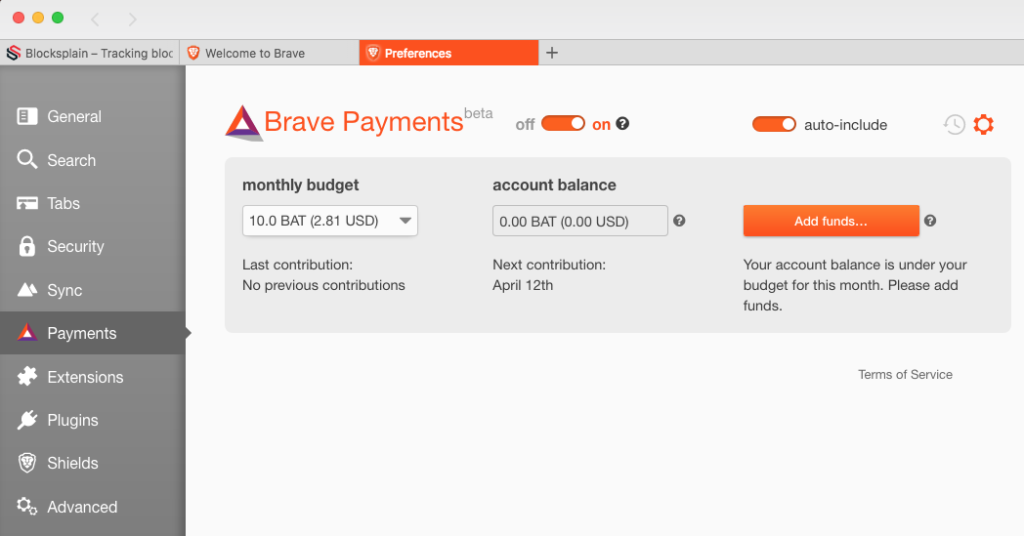Part of the reason I started Blocksplain this year was to experiment with new ways of earning revenue from blogging. Perhaps cryptocurrencies will finally make micropayments a reality, I thought, or maybe the token business model will enable content creators to get a slice of platform revenues at long last.
Indeed there are blockchain experiments happening with both micropayments (SatoshiPay, BlockStream’s Lightning Charge) and token sharing (Steemit, Po.et). But now I’ve found a blockchain startup that does both: Brave. Even better, it’s using the good old Web browser as its flagship product.
Brave was co-founded by Brendan Eich, a Hall-of-Famer in the Web world. He created JavaScript and co-founded both Mozilla and Firefox. So it’s fair to say Brave had a fantastic pedigree from day one. The other co-founder is Brian Bondy, who was a senior software engineer at Mozilla from 2011-2014.
When Brave was first released, in January 2016, the focus was primarily on the Web user. In his debut blog post, Eich promised that Brave would “fix the Web” by blocking all ad trackers and not storing any user data in its cloud. But there was also a hint that publishers would benefit from this new system too. Brave would let publishers run “anonymous ads,” Eich wrote. A week later, he clarified that Brave would essentially screen ads for the user, making them “better ads with high performance and privacy.”
In that second post, Eich also added micropayments to the mix. “We want to enable micropayments as an alternative [to ads], without requiring infrastructure changes from websites and publishers.”

In September 2016, the micropayments part went live. Called Brave Payments, it was described as a “Bitcoin-based micropayments system that can automatically and privately pay your favorite websites.” But it wasn’t long before Brave switched out Bitcoin for its own, native, token called BAT (Basic Attention Token). The token sale of BAT occurred at the end of May last year, when Brave raised $35 million in about the same amount of seconds.
Let’s skip ahead to March 2018, and see where Brave has gotten to with its token sharing and micropayments model.
The emphasis is still mostly on the user – and in particular, protecting your privacy. When you download the browser and first open it, you’re prompted to import your data, “adjust your shields” (the ad blocking part), and enable some extensions.
The first website I visited in Brave was, of course, Blocksplain. Since it only began a month and a half ago, there are no adverts on the site currently. I was pleased to see that Brave only picked up one tracker it didn’t like: Google Analytics.
 I’m not sure why Google Analytics is bad, since its purpose is to tell publishers how many people visit their lovingly crafted websites. So I clicked the “Shields Down” button after taking this screenshot (and I hope you do too).
I’m not sure why Google Analytics is bad, since its purpose is to tell publishers how many people visit their lovingly crafted websites. So I clicked the “Shields Down” button after taking this screenshot (and I hope you do too).
So how does one pay publishers? I went back to the Welcome page and scrolled down to the Brave Payments section, which was below the fold:

I clicked that button and opted in to Brave Payments.

If you click ‘Add funds’ you’re taken through a process managed by a company called Uphold. Essentially you’re creating a new Brave Wallet and can transfer BTC, ETH, LTC or BAT itself into this wallet. Once you have funds, you set a monthly budget of what you’re prepared to pay publishers.
Choosing your publishers means clicking a little heart icon in the browser bar. Once clicked, it turns from grey to yellow.


At the end of each month, the monthly budget you set is divvied out to your chosen sites based on views and time spent.

(Note: even though “auto-include” is checked by default, at first it wasn’t working for me. So I had to manually click the heart icon to include sites. This fixed itself after a while.)
One more thing I tested: I visited Mike Arrington’s blog Uncrunched and clicked the heart icon there. But since Mike isn’t yet a verified Brave Payments publisher, his site doesn’t have the green verified check mark. In this case, attempts will be made to contact the publisher once they earn over $100. If unsuccessful after 90 days, those funds “will be added to the UGP (User Growth Pool).”
Signing up to receive payments is pretty easy too. First I was prompted to “Become a Verified Publisher,” which I duly clicked. After my email was verified, I set up my Brave Wallet and then added my site by clicking “Add Channel.” Since I use WordPress to run Blocksplain, there is a handy plug-in which made this process simple to complete.
The whole process, both as a user making payments and a publisher hoping to receive them, was straight forward. My only minor gripe is that I didn’t find the little grey/yellow heart icon very intuitive, especially when the auto-include wasn’t working. But Brave Payments is still new and I’m sure the process will be made even easier in coming months.
Conclusion
As a micropayments platform, Brave Payments has tremendous promise. I like that you can set a monthly amount and then select the sites you want to reward. And the native Brave token, BAT, looks like a token with actual utility. As I write this, the market value of one BAT is US$0.259914 (it got up to about $0.90 in early January). So it’s still reasonably priced, but has the potential to increase markedly the more users Brave attracts.
The company is also running some smart marketing campaigns to attract more users. The latest is a “Million Dollar referral program to reward online publishers and YouTube creators.” Publishers get $5 for every new Brave user that signs up using their referral link.
I’m going to take shameless advantage of that here: click here to sign up to Brave and put $5 into my Brave Payments account. FYI: “A qualified referral is a user who downloads the Brave browser using the promo link specific to your channel or web site and uses the browser (minimally) over a 30 day period.”
As for me, I’m going to give Brave a go as my primary browser for the next month and see how I like it.

